Brick walls excel as thermal energy banks due to their high thermal mass. Their dense composition allows them to absorb and store significant amounts of heat energy throughout the day. As temperatures drop, they slowly release this stored warmth, helping regulate indoor temperatures. This process reduces your reliance on heating and cooling systems, leading to improved energy efficiency and lower utility costs. Brick's natural properties, including its specific heat capacity and thermal conductivity, contribute to its effectiveness in maintaining comfortable living spaces. The benefits extend beyond temperature control, offering durability, moisture regulation, and cost-effectiveness that enhance your home's overall performance.
Thermal Mass Explained

While many people think of insulation when considering energy efficiency, thermal mass plays an equally important role in regulating indoor temperatures.
Thermal mass refers to a material's ability to absorb, store, and release heat energy over time. It's a property that allows certain materials, like brick, to act as thermal batteries in buildings.
When you understand thermal mass, you'll see why brick walls are excellent thermal energy banks. They absorb heat during warm periods and release it when temperatures drop. This process helps stabilize indoor temperatures, reducing the need for heating and cooling systems.
The effectiveness of thermal mass depends on several factors:
- Density: Denser materials store more heat.
- Specific heat capacity: How much energy a material can hold per unit of mass.
- Thermal conductivity: How quickly heat moves through the material.
Brick excels in these areas, making it an ideal thermal mass material. It absorbs heat slowly during the day and releases it gradually at night, creating a more comfortable living environment.
This natural temperature regulation can greatly reduce your energy costs and carbon footprint.
Brick Composition and Properties
Brick's remarkable thermal mass properties stem from its unique composition and physical characteristics. When you examine a brick, you'll find it's made primarily from clay, shale, or a combination of both. These materials are mixed with water and other additives, then molded and fired at high temperatures.
The firing process creates a dense, porous structure that's key to brick's thermal performance. This density allows bricks to absorb and store large amounts of heat energy. You'll notice that bricks heat up slowly but retain warmth for extended periods. This is due to their high specific heat capacity, which measures the amount of energy required to raise the temperature of a material.
Bricks also have low thermal conductivity, meaning they resist heat flow. This property helps them maintain a stable internal temperature despite fluctuations in the surrounding environment.
Additionally, the surface texture and color of bricks can affect their thermal behavior. Darker bricks absorb more solar radiation, while lighter ones reflect more heat. By understanding these properties, you can optimize brick walls' performance as thermal energy banks in various climates and building designs.
Heat Absorption Capacity
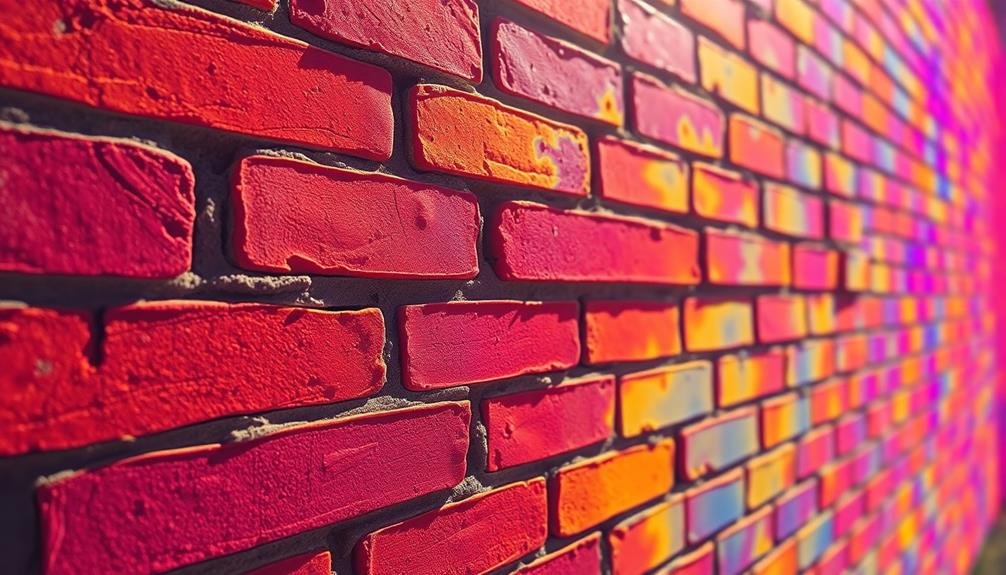
You'll find that bricks possess a high specific heat capacity, allowing them to absorb and store significant amounts of thermal energy.
This property contributes to their excellent thermal mass characteristics, enabling brick walls to effectively regulate indoor temperatures.
As a result, you can leverage brick walls as efficient thermal energy banks, helping to maintain comfortable conditions within your building.
High Specific Heat Capacity
One of the key properties that make brick walls excellent thermal energy banks is their high specific heat capacity. This characteristic allows bricks to absorb and store large amounts of heat energy without greatly increasing their temperature.
You'll find that brick walls can effectively regulate indoor temperatures by absorbing excess heat during the day and releasing it slowly at night.
The high specific heat capacity of bricks offers several advantages:
- Temperature stability: Brick walls help maintain a consistent indoor temperature, reducing the need for constant heating or cooling.
- Energy efficiency: By storing and releasing heat gradually, brick walls can lower your energy consumption and utility costs.
- Thermal comfort: The slow heat transfer process creates a more comfortable living environment, preventing rapid temperature fluctuations.
You'll notice that brick walls feel cool to the touch on hot days and warm on cold days. This is due to their ability to store heat energy and release it slowly.
As a result, brick buildings often require less artificial heating and cooling, making them more sustainable and energy-efficient. The high specific heat capacity of bricks contributes greatly to their effectiveness as thermal energy banks.
Thermal Mass Properties
Closely related to their high specific heat capacity is the thermal mass property of brick walls. This characteristic allows bricks to absorb and store significant amounts of heat energy, making them excellent thermal regulators in buildings. You'll find that brick walls can absorb heat during the day and release it slowly at night, helping to maintain a stable indoor temperature.
The thermal mass of brick walls offers several benefits:
| Benefit | Description |
|---|---|
| Temperature Stability | Reduces temperature fluctuations |
| Energy Efficiency | Decreases heating and cooling costs |
| Comfort | Maintains a more consistent indoor climate |
| Passive Solar Design | Enhances the effectiveness of solar heating |
You'll notice that brick walls take longer to heat up and cool down compared to lighter materials. This delay, known as thermal lag, can be advantageous in moderating temperature extremes. During summer, brick walls absorb heat throughout the day, keeping interiors cooler. At night, they release this stored heat, reducing the need for artificial heating. In winter, they work similarly, capturing and storing heat from the sun or indoor heating systems, then slowly releasing it to maintain warmth. This property makes brick walls an excellent choice for energy-efficient building design, particularly in climates with significant temperature variations.
Slow Heat Release Process
During the slow heat release process, brick walls gradually emit stored thermal energy back into the surrounding space. This characteristic is what makes brick walls so effective as thermal energy banks. As the ambient temperature drops, the heat stored within the bricks begins to flow outward, helping to maintain a more stable indoor temperature.
You'll notice this process occurring in three distinct phases:
- Initial release: As the air cools, the outer surface of the brick starts to release heat.
- Sustained emission: Heat continues to flow from deeper within the brick, creating a steady stream of warmth.
- Gradual dissipation: The rate of heat release slows as the temperature difference between the brick and the air decreases.
This slow release of heat can considerably reduce your heating needs during cooler periods. It's particularly effective in climates with large daily temperature swings, as the bricks can absorb excess heat during the day and release it at night.
You'll find that rooms with brick walls often feel more comfortable and require less artificial heating, thanks to this natural temperature regulation process. The slow heat release also helps prevent rapid temperature fluctuations, contributing to a more stable and comfortable indoor environment.
Temperature Regulation Benefits
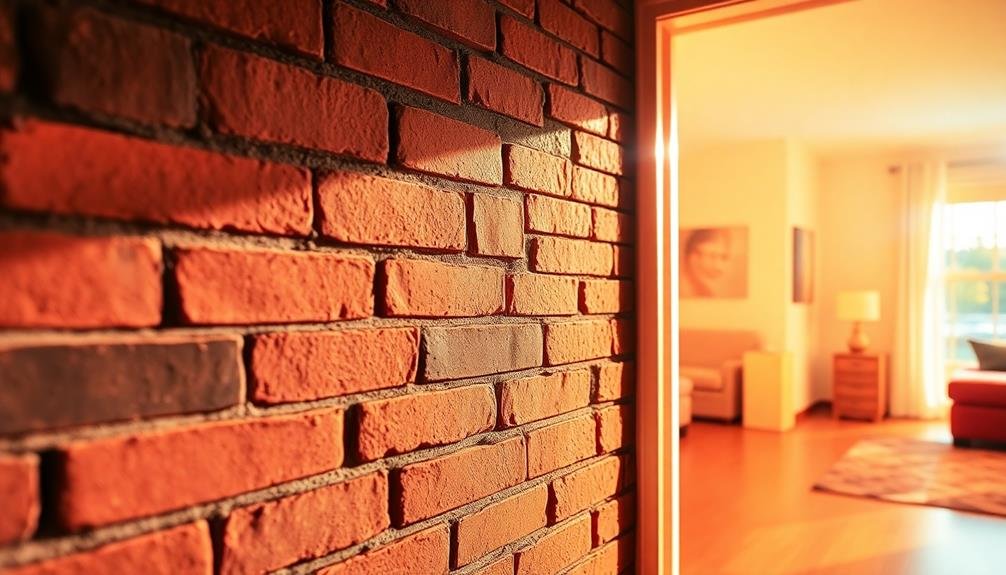
The temperature regulation benefits of brick walls extend far beyond their slow heat release properties. They act as natural thermostats, helping to maintain a comfortable indoor environment throughout the day and night.
You'll notice that brick walls can markedly reduce temperature fluctuations in your home, creating a more stable and pleasant living space. During hot summer days, brick walls absorb excess heat, keeping your interior cooler. As the temperature drops in the evening, they slowly release this stored heat, reducing the need for artificial heating.
In winter, the process works in reverse. The bricks capture and store warmth from the sun or your heating system during the day, then gradually release it at night, helping to keep your home cozy.
This natural temperature regulation can lead to substantial energy savings. You'll likely find yourself relying less on air conditioning and heating systems, which can translate to lower utility bills.
Additionally, the consistent temperature provided by brick walls can improve your overall comfort, potentially enhancing sleep quality and reducing temperature-related stress on your body.
Energy Efficiency Advantages
You'll find that brick walls excel at retaining heat, acting as thermal energy banks throughout the day and night.
This heat retention capability means your home stays warmer for longer periods, reducing the need for constant heating.
As a result, you'll see a noticeable decrease in energy consumption, leading to lower utility bills and a more environmentally friendly living space.
Heat Retention Capabilities
Brick walls stand out as exceptional thermal energy banks, offering considerable advantages in heat retention and overall energy efficiency. You'll find that these sturdy structures can absorb and store heat during the day, slowly releasing it as temperatures drop at night. This process, known as thermal mass, helps maintain a more consistent indoor temperature, reducing the need for constant heating and cooling.
The heat retention capabilities of brick walls are enhanced by several factors:
- Density: Bricks have a high density, allowing them to store more heat than lighter materials.
- Specific heat capacity: Bricks can absorb a considerable amount of heat before their temperature rises, making them excellent thermal regulators.
- Thermal conductivity: Bricks conduct heat slowly, which helps distribute warmth evenly throughout your living space.
You'll notice that brick walls can considerably reduce your energy consumption by minimizing temperature fluctuations. They're particularly effective in climates with large daily temperature swings, as they help buffer against extreme heat and cold.
Reduced Energy Consumption
Harness the power of brick walls to markedly reduce your energy consumption. Brick's thermal mass properties allow it to absorb and store heat during the day, releasing it slowly at night. This natural temperature regulation reduces the need for artificial heating and cooling, lowering your energy bills considerably.
You'll find that brick walls provide excellent insulation, keeping your home warm in winter and cool in summer. This means you'll rely less on HVAC systems, cutting down on electricity usage. Additionally, brick's durability guarantees long-lasting energy efficiency without frequent replacements or repairs.
| Energy Efficiency Aspect | Brick Wall Advantage |
|---|---|
| Temperature Regulation | Natural heat storage |
| Insulation | Reduced HVAC use |
| Durability | Long-term efficiency |
| Air Tightness | Minimal heat loss |
| Thermal Bridging | Reduced cold spots |
Seasonal Performance Differences
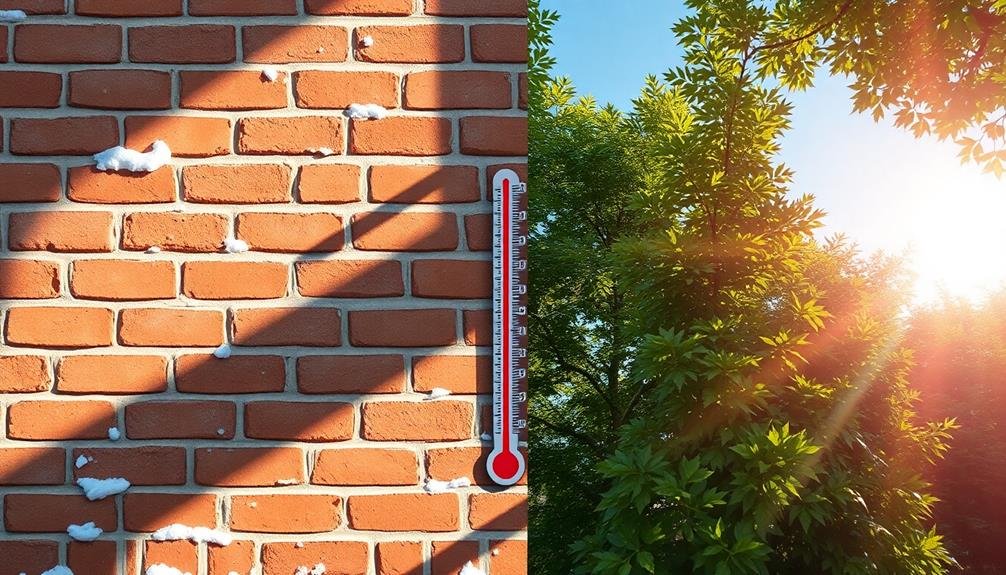
Throughout the year, brick walls exhibit distinct thermal performance characteristics that considerably impact their energy-storing capabilities.
In summer, you'll notice that brick walls absorb heat during the day, helping keep your interior cooler. As night falls, they release this stored heat, potentially reducing your need for air conditioning.
Winter presents a different scenario. Brick walls capture and store heat from the sun and your home's heating system during the day. This stored warmth is then slowly released into your living spaces at night, potentially lowering your heating costs.
The seasonal effectiveness of brick walls as thermal energy banks depends on several factors:
- Wall thickness: Thicker walls store more heat, enhancing their performance in both summer and winter.
- Exterior color: Darker bricks absorb more solar heat, which can be beneficial in winter but may require additional cooling in summer.
- Insulation: Proper insulation works with the brick's thermal mass to maximize energy efficiency year-round.
You'll find that brick walls' thermal performance varies not just between seasons, but also between day and night, making them a dynamic component in your home's energy management system.
Insulation and Brick Synergy
When considering the thermal performance of brick walls, you can't overlook the role of insulation. Properly insulated brick walls create a powerful synergy that enhances the overall thermal efficiency of a building. The bricks act as a thermal mass, absorbing and storing heat, while the insulation slows down heat transfer between the interior and exterior.
You'll find that the combination of bricks and insulation works in two ways. First, it prevents rapid heat loss during colder months, keeping your interiors warm and reducing heating costs. Second, it delays heat gain during hot weather, maintaining a cooler indoor environment and decreasing air conditioning needs.
The type and placement of insulation matter considerably. You can opt for cavity wall insulation, where insulating material is placed between the inner and outer brick layers, or external insulation, which is applied to the outer surface of the brick wall.
Each method has its advantages, depending on your specific needs and building structure. By carefully selecting and implementing insulation alongside your brick walls, you'll maximize the thermal energy storage capabilities of the bricks while minimizing unwanted heat transfer.
Passive Solar Design Integration

Passive solar design seamlessly integrates with brick walls to create an energy-efficient building system.
You'll find that this combination maximizes natural heating and cooling, reducing your reliance on artificial climate control.
Brick's thermal mass properties complement passive solar strategies by absorbing, storing, and gradually releasing heat throughout the day.
To effectively incorporate passive solar design with brick walls, you'll want to:
- Orient your building to maximize southern exposure, allowing winter sun to warm the brick surfaces
- Install properly sized windows on the south-facing walls to capture sunlight and heat
- Use overhangs or shading devices to prevent overheating during summer months
Moisture Regulation Effects
Beyond their thermal properties, brick walls play an essential role in regulating moisture within a building. They act as a natural buffer, absorbing excess moisture from the air when humidity is high and releasing it when the air becomes drier. This process, known as hygroscopic buffering, helps maintain a more stable indoor environment.
You'll find that brick's porous nature allows it to absorb up to 20% of its weight in water without compromising its structural integrity. This characteristic prevents condensation on the wall's surface, reducing the risk of mold growth and improving indoor air quality.
Additionally, brick walls can help mitigate the effects of sudden humidity changes, which is particularly beneficial in climates with significant temperature fluctuations.
When you incorporate brick walls into your building design, you're also creating a natural vapor barrier. This feature helps regulate the movement of moisture through the wall assembly, preventing issues like interstitial condensation.
As a result, you'll experience improved energy efficiency and a more comfortable living space. The moisture regulation effects of brick walls complement their thermal mass properties, making them an excellent choice for sustainable and healthy building design.
Durability and Longevity Factors
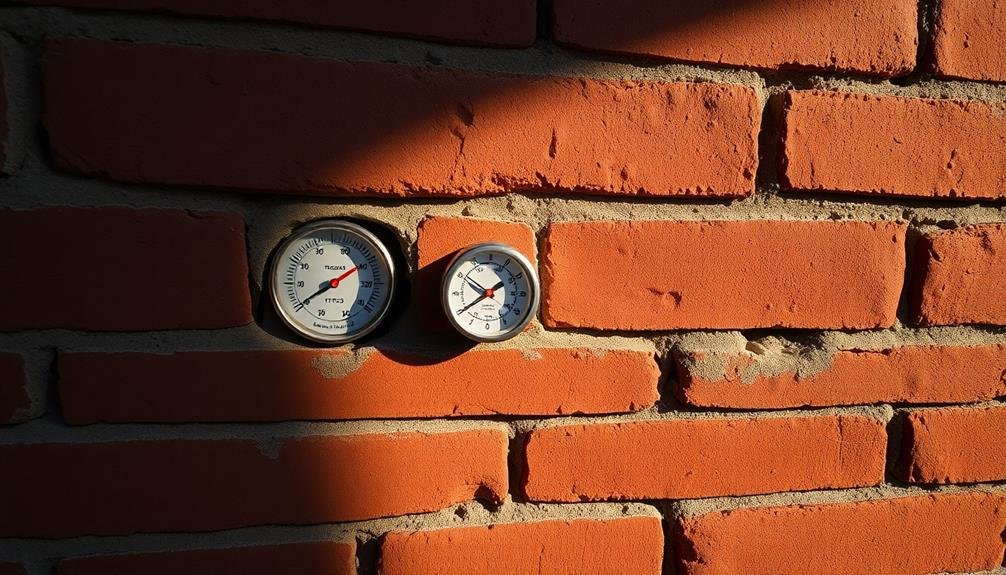
When you consider brick walls as thermal energy banks, you can't overlook their impressive durability and longevity.
Brick's weather resistance means your walls will stand strong against rain, wind, and temperature fluctuations for decades.
You'll appreciate the low maintenance requirements and long-term structural integrity, which contribute to the overall efficiency and value of your brick-walled home.
Weather Resistance
Brick walls' weather resistance plays an essential role in their durability and longevity as thermal energy banks. You'll find that bricks can withstand various weather conditions, from scorching heat to freezing temperatures, without significant deterioration. This resilience guarantees that the wall's thermal mass properties remain intact over time, allowing it to consistently store and release heat.
When you're considering brick walls as thermal energy banks, their weather resistance offers several advantages:
- Protection against moisture: Bricks naturally repel water, preventing moisture from penetrating the wall and compromising its structural integrity.
- Resistance to UV radiation: Unlike some materials that fade or degrade under sunlight, bricks maintain their appearance and performance.
- Wind resistance: Brick walls can withstand high winds, guaranteeing they remain stable and continue to function as effective thermal masses.
You'll appreciate that this weather resistance translates to low maintenance requirements and extended lifespan. Brick walls don't need frequent repairs or replacements, which means they'll continue to serve as efficient thermal energy banks for decades.
This durability contributes to their overall sustainability and makes them an excellent choice for long-term energy conservation strategies.
Low Maintenance Requirements
The low maintenance requirements of brick walls further enhance their appeal as thermal energy banks.
You'll find that brick walls are incredibly durable and long-lasting, requiring minimal upkeep over their lifetime. Unlike other building materials, bricks don't rot, warp, or become infested with pests. They're resistant to fire, mold, and mildew, which means you won't need to worry about frequent repairs or replacements.
Brick walls don't require painting or sealing, saving you time and money on regular maintenance tasks. They'll retain their color and appearance for decades, even in harsh weather conditions. You'll only need to clean them occasionally with a simple pressure wash or mild detergent solution to keep them looking fresh.
The mortar between bricks may need repointing every few decades, but this is a relatively simple and infrequent task.
Brick walls' low maintenance nature contributes to their efficiency as thermal energy banks, as you won't need to disrupt the wall's structure for repairs or replacements. This stability guarantees that the thermal mass remains intact, consistently providing energy-saving benefits throughout the building's lifespan.
Structural Integrity Over Time
You can count on brick walls to stand the test of time when it comes to structural integrity. Bricks have been used for thousands of years, and many ancient structures still stand today, testifying to their durability. The composition of bricks, typically made from fired clay, contributes to their long-lasting nature and resistance to various environmental factors.
When you're considering the structural integrity of brick walls over time, keep these key factors in mind:
- Weather resistance: Brick walls withstand extreme temperatures, rain, snow, and wind without notable deterioration.
- Fire resistance: Bricks don't burn, making them an excellent choice for fire-safe construction.
- Pest resistance: Unlike wood, bricks aren't susceptible to termites or other wood-boring insects.
As brick walls age, they often become stronger due to a process called carbonation, where calcium hydroxide in the mortar reacts with carbon dioxide from the air. This reaction forms calcium carbonate, which increases the wall's strength over time.
Additionally, proper construction techniques and regular maintenance can meaningfully extend the lifespan of brick walls, ensuring they remain structurally sound for generations to come.
Cost-Effectiveness of Brick Walls
While initially more expensive than some alternatives, brick walls often prove cost-effective in the long run.
You'll find that their durability and low maintenance requirements contribute greatly to their overall value. Brick walls can last for centuries with minimal upkeep, saving you money on repairs and replacements over time.
You'll also benefit from reduced energy costs. Brick's thermal mass properties help regulate indoor temperatures, reducing your reliance on heating and cooling systems. This can lead to considerable savings on your energy bills year-round.
Consider the fire resistance of brick walls, which can lower your insurance premiums.
Their ability to withstand extreme weather conditions also means you'll spend less on storm damage repairs.
When you factor in the increased property value that brick construction often brings, you'll see that the initial investment pays off.
Brick homes typically have higher resale values and are more attractive to potential buyers.
Don't overlook the environmental benefits.
Brick's longevity and natural composition make it an eco-friendly choice, potentially saving you money on green building certifications or energy-efficiency upgrades in the future.
Frequently Asked Questions
Can Brick Walls Be Painted Without Affecting Their Thermal Properties?
You can paint brick walls without considerably impacting their thermal properties. However, you'll want to use breathable, vapor-permeable paints to maintain the wall's ability to absorb and release moisture. This preserves the brick's natural thermal characteristics.
How Do Different Brick Colors Impact Heat Absorption and Retention?
You'll find that darker brick colors absorb more heat, while lighter colors reflect it. This means dark bricks retain warmth longer, but they'll also get hotter. Light-colored bricks stay cooler but don't store as much heat.
Are There Specific Brick Patterns That Enhance Thermal Energy Storage?
You'll find that certain brick patterns can boost thermal energy storage. Interlocking designs and thicker walls increase mass, while patterns with air pockets provide insulation. Herringbone and Flemish bond patterns are particularly effective for heat retention.
Can Old Brick Walls Be Retrofitted to Improve Their Thermal Mass Capabilities?
Yes, you can retrofit old brick walls to improve their thermal mass. You'll want to add insulation, seal gaps, and consider applying a thermal coating. Don't forget to check for moisture issues before starting any improvements.
How Do Brick Walls Compare to Other Materials for Soundproofing?
You'll find brick walls are decent for soundproofing, but not the best. They're better than drywall but less effective than concrete or specialized acoustic materials. Their density helps, but air gaps and other factors impact performance.
In Summary
You've learned why brick walls excel as thermal energy banks. They absorb heat slowly, store it efficiently, and release it gradually due to their composition and properties. You've seen how they regulate temperature, integrate with passive solar design, and manage moisture. You've discovered their durability and cost-effectiveness. Now you understand why brick walls are an excellent choice for energy-efficient construction and comfortable living spaces.


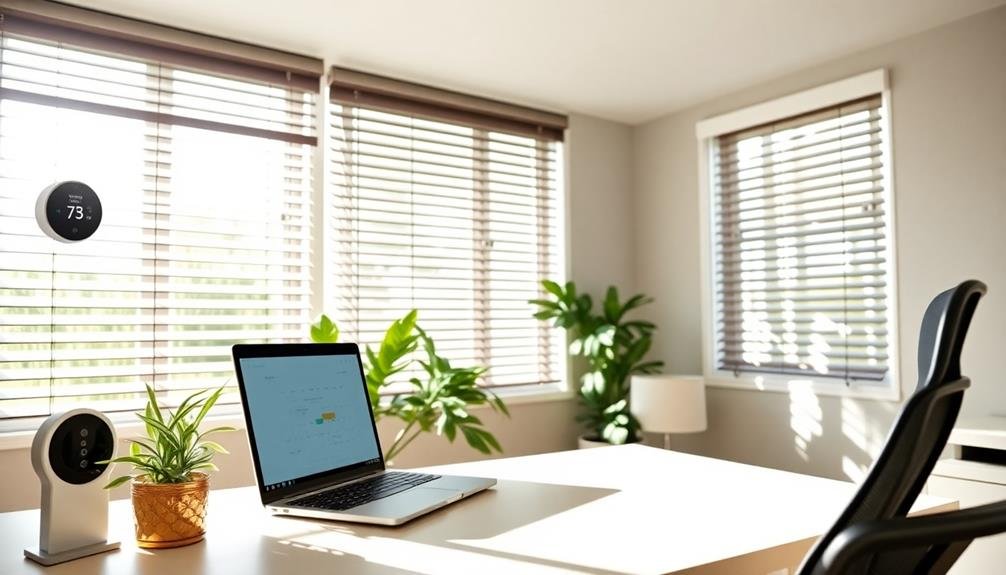
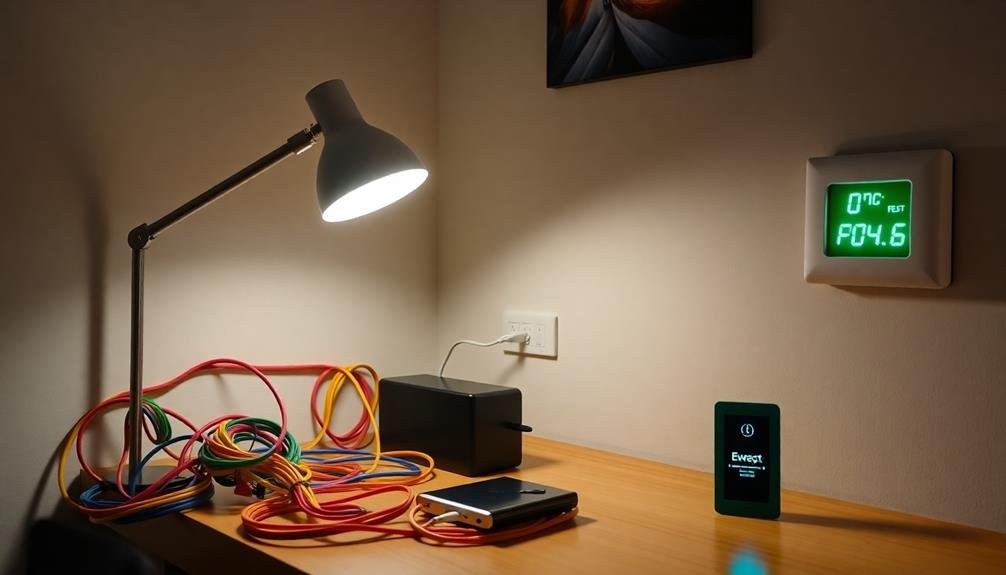

Leave a Reply